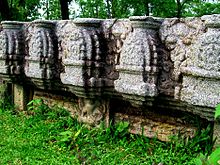This is an old revision of this page, as edited by Bhaskarbhagawati (talk | contribs) at 19:47, 15 December 2012 (←Created page with 'right|thumb|<center>Ruins of ] File:Madan kamdev ruins.J...'). The present address (URL) is a permanent link to this revision, which may differ significantly from the current revision.
Revision as of 19:47, 15 December 2012 by Bhaskarbhagawati (talk | contribs) (←Created page with 'right|thumb|<center>Ruins of ] File:Madan kamdev ruins.J...')(diff) ← Previous revision | Latest revision (diff) | Newer revision → (diff)

Kamrup is historical region encompassing entire Brahmaputra Valley with Western part (of valley) serving most important role as capital while North Bengal as Western and parts of Bangladesh as southern boundary. Ramayana and Mahabharata refers this region as Pragjyotish not as Kamrup. Puranas written after Mahabharata mentions same Pragjyotish as Kamrup. Vishnu Purana describes Kamrup spread 450 miles in all directions from Kamakhya. Kalika Purana says Kamakhya as center or heart of Kamrup. Yogini Tantra composed thereafter gives the geographical area of Kamrup as entire Brahmaputra Valley, Bhutan, Rangpur (Bangladesh), Mymensing (Bangladesh), Cooch Behar. Chinese pilgrimage Yuan Chwang gives detail account of ancient Kamrup. Staying for a period of three months in what is current Guwahati, he observes the life, culture and politics in Kamrup. First millennium common era marks expansion of geographical, political and cultural influence of Kamrup than never before.
In medieval times in absence of local rulers, it became an battlefield of different powers trying to control over Kamrup but none can hold Kamrup for long thus it remain untouched by any foreign cultural influences including in its language. Though Kamrup is going through such hostile environment same time saw rise of major literary activities. Chandra Bharati, Bhattadeva, Ananta Kandali, Madhava Kandali, Sankardeva composed epics in Kamrupi language.
Colonial period seen Kamrup reducing its size than never before and limited to an administrative district with separation of most of North Bengal areas.


Twentieth century marks major industrial development of Kamrup. Guwahati, the largest city of region, became major urban center by showing character of an city in real means. Thus cultural and political capital city of ancient Kamrup became major hub of culture and business again.
See also
References
- Sen, Dineschandra (1988). The Ballads of Bengal - Volume 1. Mittal Publications. p. 375.
{{cite book}}: Cite has empty unknown parameter:|coauthors=(help) - Alam, Khorshed (2001). Guwahati: the gateway to the east. Concept Publishing Company.
{{cite book}}: Cite has empty unknown parameter:|coauthors=(help)